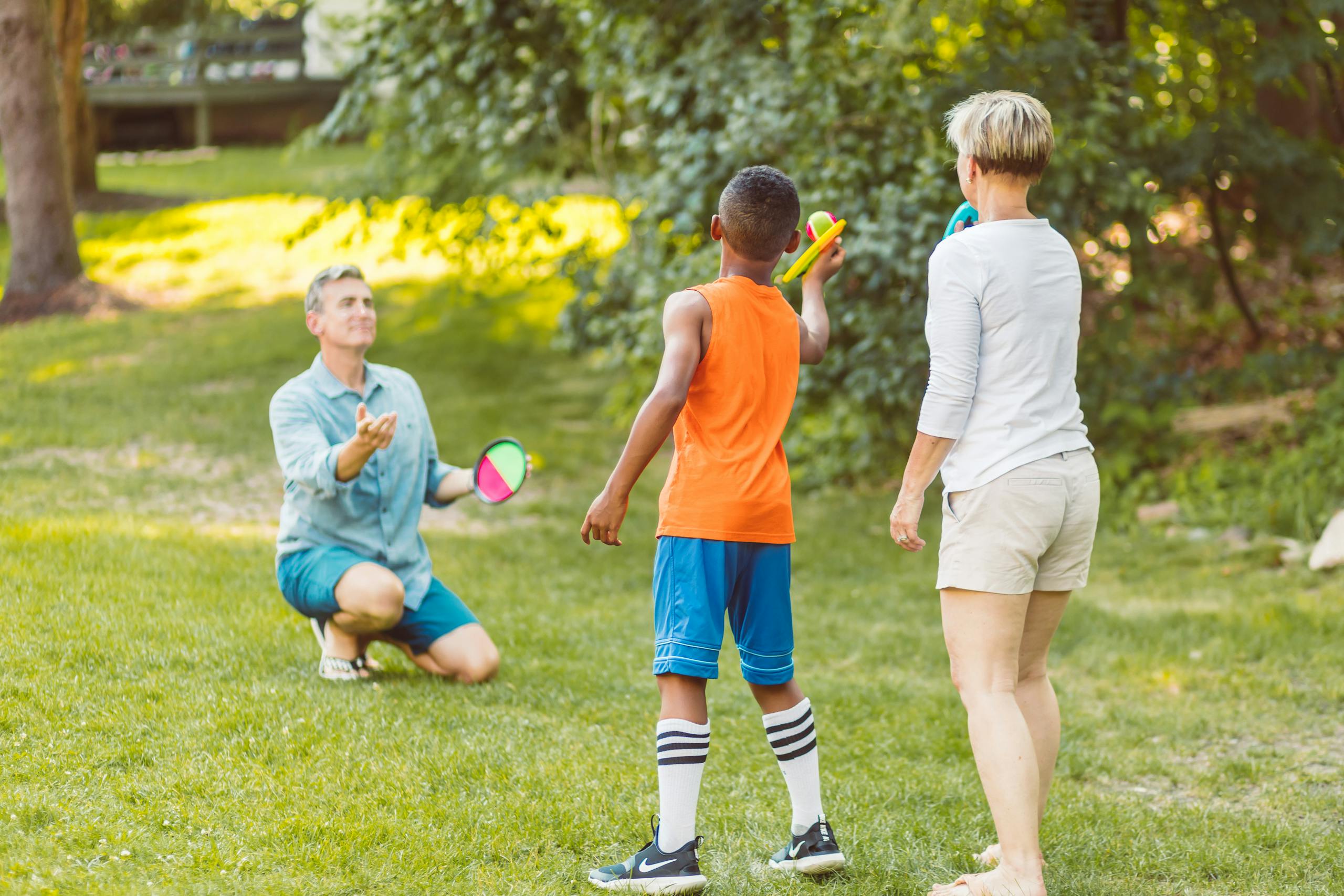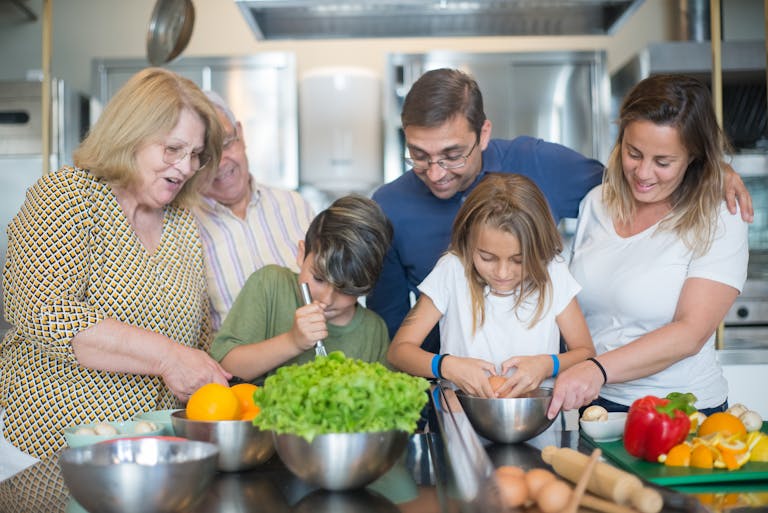We’ve all been there. You suggest family time, and suddenly everyone has somewhere else to be. The kids are glued to their screens, someone’s complaining about being bored before you’ve even started, and you’re left wondering how other families make it look so effortless on social media.
But here’s the thing—family time doesn’t have to feel like pulling teeth. The secret sauce? Finding activities that sneak in the good stuff (exercise, fresh air, life skills) while everyone’s having fun. No lectures about screen time limits or guilt trips about getting moving.
Studies show that families who engage in regular physical activities improve their physical health and strengthen emotional bonds and communication. The challenge isn’t convincing your family that healthy activities matter—finding ones that don’t feel like work. These activities are also a great way to spend quality time together and support everyone’s mental well-being.
Ready to transform your family time from “do we have to?” to “can we do that again?” Here are seven activities that’ll get everyone moving, laughing, and maybe even asking for more family time. Yes, really.
1. Nature Hikes That Double as Adventure Quests
Telling your kids, “We’re going for a hike,” might get you some serious eye rolls. But frame it as a treasure hunt or mystery mission? Suddenly, you’ve got their attention.
Transform your local trails into adventure zones by creating themed quests. Plan a nature walk to enjoy the beautiful scenery along the way. Challenge everyone to spot five different types of leaves, find the coolest rock formation, or take photos of animals in their natural habitat. For younger kids, bring along a simple checklist of things to see. Older ones might enjoy geocaching—basically, treasure hunting with GPS coordinates.
The health benefits are apparent: fresh air, cardiovascular exercise, and vitamin D from sunshine. But the hidden perks are just as valuable. Hiking naturally encourages conversation (something about walking side-by-side makes kids more likely to open up), teaches problem-solving skills when navigating trails, and helps everyone develop an appreciation for nature.
Pro tip: Let different family members take turns being the “quest leader” for each hike. Kids love having control, and you’ll be surprised by their creativity.
2. Dance Party Nights in Your Living Room
Nothing says “we’re fun parents” quite like busting out your most ridiculous dance moves in the living room. And yes, your teenagers will be mortified—until they’re secretly laughing and joining in.
Create playlists that include everyone’s favorites. Mix in some ‘80s classics (your moment to shine); current hits the kids love, and maybe some throwback Disney songs for pure nostalgia. The key is variety and volume that encourages movement, not conversation.
These impromptu fitness activities disguised as pure silliness provide excellent cardio, release endorphins, and create the memories your kids will still laugh about in college. These dance parties boost everyone’s energy and are so much fun for all ages. Plus, there’s something magical about seeing your usually serious teenager attempt the floss dance while your spouse tries remembering how to do the electric slide.
Make it even more engaging by having themed nights—‘90s music, movie soundtracks, or songs from different decades. You could even let each family member DJ for 15 minutes and watch the musical chaos unfold.
3. Meal-Prep Parties for Foodies in Training
Cooking together transforms a necessary life skill into quality bonding time. But instead of the usual “help Mom make dinner” routine, turn it into a friendly competition or collaborative project.
Try “Chopped: Family Edition,” where everyone gets the same basic ingredients and creates their healthy dish. Or assign each family member a component of the meal—one person handles the salad, another tackles the main course, and someone else is on dessert duty.
Kids who participate in meal preparation are likelier to try new foods and develop healthier eating habits. They learn practical skills like measuring, following directions, and kitchen safety. But the real magic happens during the process—the conversations while chopping vegetables, the teamwork required to coordinate multiple dishes, and the pride everyone feels when sitting down to a meal they created together.
Start simple with dishes like build-your-own tacos, homemade pizza with various toppings, or colorful fruit and veggie skewers. You can tackle more complex recipes together as everyone gets more comfortable in the kitchen.
For a creative keepsake, encourage family members to write down their favorite recipes or work together to write and compile a family cookbook.
4. Weekend Bike Rides to Explore Your Neighborhood
Something about the wind in your hair and wheels beneath you makes even familiar neighborhoods feel like new territories waiting to be explored.
Plan routes with interesting stops—a playground for the younger kids, a coffee shop for a mid-ride treat, or a scenic overlook for family photos. The journey becomes the destination, and fitness happens naturally while everyone’s focused on the adventure.
Biking provides excellent low-impact cardiovascular exercise while building leg strength and improving balance. It also develops coordination and spatial awareness in kids. Biking is especially beneficial for cardiovascular and heart health, helping your family stay active and supporting overall wellness. For parents, it’s a chance to see their community from a different perspective and maybe discover that cute bakery they’ve been driving past for years. Try to track your family’s biking routes or progress to stay motivated and help everyone stay active.
Safety first: Ensure everyone has properly fitted helmets and choose bike paths or quiet streets appropriate for your youngest rider’s skill level. Consider bringing a basic repair kit and teaching older kids how to fix a flat tire—another life skill disguised as family fun.
5. Screen-Free Challenges for Connection and Creativity
Announcing a screen-free day might initially sound like you’re suggesting voluntary torture to your family. But once the initial withdrawal symptoms pass (and yes, there might be some dramatic sighing), you’ll be amazed at what emerges.
Set up engaging alternatives, such as board game tournaments, puzzle challenges, family storytelling sessions where everyone contributes a sentence to create a ridiculous story, or arts and crafts projects using materials you already have at home—try using cardboard boxes for creative building. Art projects are a great way to express creativity together. Consider visiting your local library to find inspiration for family storytelling sessions or borrow mystery books for a family game. Families can also practice storytelling or creative skills during these screen-free sessions.
The goal isn’t to demonize technology but to create space for different types of interaction. Without the constant ping of notifications and the pull of individual screens, families often discover they enjoy talking to each other. Wild concept, right?
Start small—maybe a few hours on Sunday afternoon—and let the success build naturally. Your tween might initially act like they’re being punished, but wait until everyone’s crying with laughter over a heated game of charades.
6. Gardening Together: Growing Fun and Fresh Food
You don’t need acres of land or a green thumb to start a family garden. A few pots on a balcony, a small raised bed, or a windowsill herb garden can provide months of healthy family activities.
Let each family member choose something they want to grow—cherry tomatoes, herbs for cooking, flowers for beauty, or vegetables they want to eat. The physical activity of digging, planting, watering, and harvesting uses your whole body, making gardening a full-body activity that helps build muscle strength and contributes to overall health. These activities keep everyone moving while teaching patience and responsibility.
Kids develop a connection to their food when they’ve watched it grow from seed to plate. They’re more likely to try vegetables they’ve nurtured, and there’s genuine pride in serving a salad made from their lettuce.
The daily care required creates natural opportunities to spend time together outdoors. Watering becomes a shared morning routine, and checking plant progress provides built-in conversation starters about growth, patience, and the natural world.
7. DIY Obstacle Courses for Backyard Fun
Transform your outdoor space into an adventure course using items you probably already have. Pool noodles become hurdles, hula hoops create targets, chairs turn into tunnels to crawl under, and rope or string can mark zigzag running patterns. To boost the cardio challenge, add classic exercises like jumping jacks and high knees at different stations.
The beauty of homemade obstacle courses is their flexibility. Adjust difficulty levels for different ages, change the layout regularly to keep it interesting, and let kids help design challenges. Some obstacles, like planks or crawling, help build core strength. You can set several repetitions for each exercise to keep things structured and safe. One day it’s a timed race, the next it’s about completing challenges as a team, helping everyone develop teamwork skills, and introducing kids to the spirit of sport and sportsmanship.
This activity combines cardiovascular exercise, coordination, balance, and problem-solving. Kids develop gross motor skills while having a blast, and parents get a workout without feeling like they’re exercising. The competitive element adds excitement, but the real fun comes from cheering each other on and laughing at the inevitable silly moments. For even more fun, include a game of play capture (capture the flag) in your outdoor sports activities.
Create themed courses, such as superhero training, ninja warrior challenges, or animal movement patterns, in which everyone has to move like different creatures through various obstacles.
Why These Family Activities Matter
These healthy family activities do double duty. On the surface, they’re about getting everyone moving, spending time outdoors, and learning new skills. But underneath, they’re building something more valuable: shared experiences that become family stories. These activities also foster a sense of belonging and achievement, helping each family member feel connected and valued.
Conversations during a nature hike, inside jokes born from terrible dance moves, and the pride kids feel when they successfully navigate an obstacle course all contribute to the foundation of strong family relationships. Participating in these activities helps improve focus and mindfulness for kids and adults, encouraging everyone to be present and attentive during shared moments.
Regular physical activity as a family establishes healthy habits without the lecture. Kids learn that movement can be joyful, that trying new things is worth the initial awkwardness, and that working together toward a goal creates stronger bonds than individual achievements.
Creating Memories That Stick
Let’s be real for a moment. Between work schedules, school activities, and the general chaos of family life, carving out time for intentional family activities can feel overwhelming. Planning activities each week helps families make the most of their free time and ensures everyone gets involved, including children of all ages. You don’t need to become the family that does elaborate themed adventures every weekend.
Start with one activity that sounds manageable for your crew. Maybe it’s a 20-minute dance party on Friday nights, an at-home workout, or a Saturday morning bike ride to grab donuts. Outdoor adventures are a fantastic way to spend quality time together, and at-home workouts are perfect for busy weeks. Visiting a local park, going ten-pin bowling, or attending sporting events are excellent ways to create memories and support physical fitness. You can also visit local houses of interest, museums, or schools for educational outings.
Encourage your family to try new activities and stay motivated by mixing things up—joining a class or group activity can introduce new ideas and open up worlds of experience. Be mindful of the risk level of different activities; choose lower-risk options when needed and be aware of higher-risk situations, especially for children. These activities are perfect for any child or family member and can be adapted to suit everyone.
Don’t stress about making every moment Instagram-worthy. The best family memories often come from the unplanned laughter, the friendly competition, and the simple pleasure of doing something together without the pressure of being anywhere else.
Here’s to more laughter, healthier habits, and the kind of family time everyone looks forward to!





